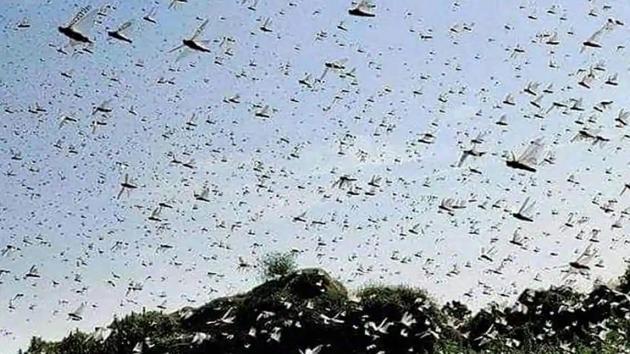Timely help to Iran helps India check locust attack
India is still among five nations which cannot lower their guard for the next four weeks, the UN’s Food and Agriculture Organisation (FAO) has said in its latest alert on June 21. mary
Indian agricultural scientists have been successful in tackling the spread of crop-devastating locusts with tight measures and by arming Iran to cut invasions towards India, helping protect 114,026 hectares of crops in six most “at-risk” states as on June 22, according to official data.

The most threatened states where locust attacks have been curbed are Rajasthan, Punjab, MP, Gujarat, Maharashtra and UP, as the country robustly heads into its summer-sown kharif crop season.
To be sure, India is still among five nations which cannot lower their guard for the next four weeks, the UN’s Food and Agriculture Organisation (FAO) has said in its latest alert on June 21.
Desert locusts can fly up to 150km daily and a one square-km swarm can eat as much food as 35,000 people in terms of weight in a single day, according to the FAO Desert Locust Information Service manual. The voracious pests, which originate in the Horn of Africa, can flatten farms overnight if not checked. Locust attacks are known to cause considerable drops in food output, roiling farm economies.
Since May, India has ramped up containment, in area terms, by 42% (from about 49,000 hectares to nearly 114,026 hectares). One hectare is roughly 2.4 acres.
The pests appeared earlier than expected this year. Adult populations set off in thick swarms from Africa, descending and breeding in several countries before entering India via Iran and Pakistan through the so-called Scheduled Desert Areas abutting the country’s western borders.
Since April, locusts have appeared in large districts such as Sriganganagar, Hanumangarh and Bikaner in Rajasthan, Moriana in Madhya Pradesh and Nashik and Nagpur regions in Maharashtra.
Among several measures taken to counter the threat, India shipped early this month nearly 20,000 litre of malathion, the main pesticide to control locusts, to Iran under a collaboration to implement strategies control strategies. Containing locusts in Iran help India because the country lies on the invasion route.
The pesticide, malathion, at 96% concentration, effectively kill locusts, according to the FAO manual. Authorities maintain stocks of minimum 5,000 litres at this concentration at “location control stations across states where pesticide can be mobilised for immediate requirement, according India’s national manual for locust control”.
A surge in locust attacks since last year is being attributed to favourable breeding weather caused by a large number of cyclones in East Africa since last year according to the FAO.
According to Anurag Srivastava, spokesperson of the ministry of external affairs, India has developed a regional cooperation mechanism involving South Asians nation to fight the pestilence. Pakistan, however, skipped a technical-level meeting with India on June 19.
“There have been no significant findings of crop damage in the locust affected states of Gujarat, MP, Rajasthan, Punjab, Maharastra and UP to new kharif crops, where containment measures and constant surveillance continue,” the official cited in the first instance said on condition of anonymity.
Millions of farmers plant a range of summer crops that account for half of India annual food output, driven by good rains. These include rice, pulses, oilseeds and millets, apart from horticulture and sugar plantations. In the last week of May, before kharif plantings, surveillance field units reported between 5% and 10% of crop damage in 1000 hectares in Sriganganagar, Hanumangarh and Bikaner of Rajasthan and 5-10% of 400 hectares in Moraina district of Madhya Pradesh.
“India has a good experience of fighting the pest from two previous outbreaks, in 1950 and 1993. This has come in handy,” said JN Thakur, a former chief of locust monitoring at the agriculture ministry.
Get Current Updates on India News, Lok Sabha election 2024 live, Election 2024 along with Latest News and Top Headlines from India and around the world.




